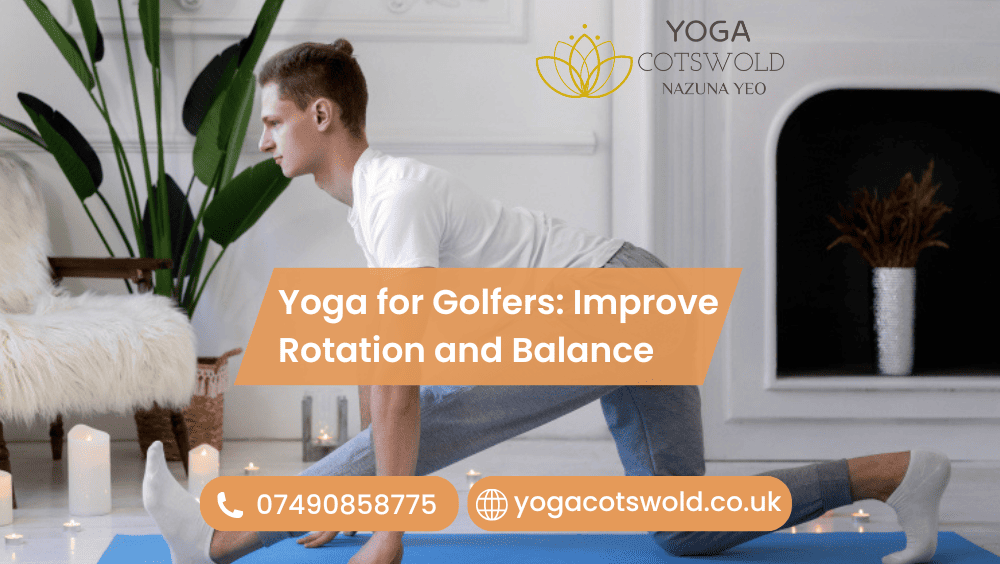Yoga for Golfers: Improve Rotation and Balance
Yoga boosts golfers’ rotation and balance. Moreover, it builds core strength and flexibility. Therefore, swings feel smoother, and accuracy improves.
HEALTH TIPS
11/18/20256 min read


However a smooth golf swing doesn’t come from brute force; rather it comes from steady footing, relaxed focus, and clear lines of movement,, Yet hours at a desk and long drives to the course often leave the the ankles sleepy,the hips grippy, and spine stiff, . Luckily, a short, well-structured practice can change all of that. In this guide, NAZUNA YEO from YOGA COTSWOLD shares a practical programme of yoga for golfers to sharpen rotation and balance, protect your back, and give you a calmer rhythm from tee to green.
Why golfers need yoga (and not just more range balls)
Golf asks for a powerful turn on a narrow base. However, most of us live in chairs, not dynamic stances. Consequently, the thoracic spine stiffens, hip flexors shorten, and the ankles forget how to talk to the ground. Because the body will always find a way to create the swing, it begins to twist from the lower back or yank from the shoulders—two places that don’t love being the prime movers. Yoga for golfers reverses that pattern by opening the chest and hips, waking the feet and glutes, and layering on core stability so rotation feels effortless rather than risky. Get details on Yoga Teacher in Upper Slaughter.
What actually powers a consistent swing
Think of the swing as three linked engines:
Ground reaction and footwork. Good balance starts at the feet. Moreover You need awareness of weight across little toe,big toe, and heel, and subtle ankle mobility
Thoracic spine & Hips. The hips coil; the ribcage rotates on a stable pelvis. That is true rotation.
Core and shoulders. A responsive trunk transfers force while shoulder mobility allows the club to travel on plane without tugging the neck.
Because of which , our plan opens the tight bits, strengthens the sleepy bits, and teaches your body to sequence them in the right order. Looking for a Yoga Teacher in Swindon Village?
Pre-round warm-up (((8–10 minutes)))
Apparently Arrive five minutes early, roll out the mat (or a towel), and move through this quick routine. Consequently Keep nasal breathing steady.
3D Rib Breathing (60 seconds). Hands around lower ribs. Inhale wide and back; exhale long. You prime breathwork and reduce shoulder tension.
Cat–Cow with Thoracic Reach (60 seconds). In addition on each exhale, round,On each inhale, lift chest;. After that add a gentle reach to the ceiling to wake thoracic mobility.
World’s Greatest Lunge (90 seconds each side). Step into a long lunge, twist towards the front knee, then sweep the back arm overhead. You’ll open hip mobility and rib rotation together.
Hip Airplanes (45 seconds each side). Stand tall, hinge from the hips, rotate pelvis open/closed while the chest stays long. This drills hip control for the backswing and follow-through.
Ankle Rockers (60 seconds). Knees track over toes as you rock forward and back. Better ankle mobility equals cleaner weight shift.
Standing Cactus with Scapula Slides (45 seconds). widen collarbones,draw shoulder blades down,Elbows at 90°,;
Split-Stance Rotations (45 seconds). Feet in a gentle lunge, arms across chest, rotate ribs left/right while hips stay square. This grooves separation of upper and lower body.
You’ll walk to the first tee taller, looser, and ready to coil without yanking your lower back. Get details on Yoga Teacher in Andoversford.
Post-round recovery (12–18 minutes)
After play, tension sits most in the front hips, the mid-back, and the forearms. This short sequence resets everything so tomorrow feels fresh.
Supported Fish (2–3 minutes). Lie over two books along the spine and head. Passive chest opening calms the nervous system. (Keywords: restorative yoga, shoulder mobility.)
Low Lunge with Side Bend (60–90 seconds each). Tailbone tucks lightly; reach the arm overhead to lengthen psoas and obliques—vital for a free follow-through.
Thread the Needle (60 seconds each). Slide one arm under the other from all fours; free the upper back and the back of the shoulder.
Figure-Four or Pigeon (90 seconds each). Choose the knee-friendly option. This releases lateral hip tightness that drags the pelvis off line.
Supine Twist (60 seconds each). Additionally Soften the waist and restore gentle spinal rotation without force.
Extensor Stretch/Forearm Flexor (45 seconds each). You can Ease the grip muscles after a long day of holding the club.
Legs Up the Wall (2 minutes). Finish with long exhales for systemic recovery.
Strength that makes rotation stick
Flexibility without control disappears under pressure. Consequently, we add micro-doses of strength three times per week.
Dead Bug (3×30 seconds). Ribs hug in; opposite arm and leg extend. Pure core stability without strain.
Bridge March (3×10). Lift hips, then march slowly. You’ll groove glute activation so hips drive the turn rather than the back.
Side Plank (knees down if needed) 3×20 seconds each. Builds lateral stability for steady posture through impact.
Prone Y-T-W (2 sets of 6 each). Lower-trap engagement widens the chest and supports shoulder mobility.
Pallof Press (band) 2×10 each side. Anti-rotation control that translates beautifully to a quiet, powerful trunk. Looking for a Yoga Teacher in Moreton-in-Marsh?
A simple weekly template
Mon: Pre-round warm-up + strength micro-dose (12–15 minutes).
Tue: Vinyasa flow (20–25 minutes) emphasising hips and ribs.
Wed: Restorative chest/hip release (15 minutes).
Thu: Pre-round warm-up + putting practice.
Fri: Strength micro-dose (12 minutes).
Weekend: join a class at YOGA COTSWOLD with NAZUNA YEO for hands-on cues. Or One combined session (30 minutes)
Usually Consistency beats intensity; small and usually wins the season.
Technique cues that transfer to the course
Ribs over pelvis. Stack softly; avoid flaring. True rotation lives in ribs and hips, not the lower back.
Tripod feet. Feel heel, big toe, and little toe. Subtle pressure shifts improve balance instantly.
Long neck, soft jaw. A hard jaw locks the shoulders. Release it and the clubhead will arc freely.
Exhale to transition. As you shift from backswing to downswing, a soft exhale steadies timing.
Common mistakes golfers make on the mat
Chasing depth over control. Deep lunges with arched backs compress the spine. Tuck lightly and lengthen.
Skipping ankles. You can’t own balance if the ankles won’t move. Keep rockers in your plan.
Holding the breath. Strain steals rotation. Slow exhalations reset tone quickly.
Only stretching, never strengthening. Without core stability and glute activation, mobility vanishes by the ninth hole. Get details on Yoga Teacher in Northleach.
Injury-safe modifications (use them proudly)
Sensitive knees: Swap pigeon for figure-four on your back; pad kneeling shapes with a folded towel.
Grumbly wrists: Forearm planks instead of high planks; fists instead of flat palms.
Tight hamstrings: usually Micro-bend knees in forward folds; you can raise heels on a towel in downward dog.
Shoulder niggles: usually Keep elbows close in low push-ups; you can choose sphinx over cobra until strength returns.
However, Modifications aren’t second-best; they’re the fastest path to consistent practice.
Breathwork for swing tempo and focus
Because golf punishes tension, breath becomes a quiet superpower.
4-6 Breathing (2 minutes). Inhale on the count of four , exhale on the count of six . Usually Longer exhales smooth transitions and calm the system .
Box Breath on the Tee (60 seconds). Inhale on the count of four , hold on the country of two , exhale on the count of four, hold on the count of two . You’ll eventually feel focused without getting drowsy.
Side-lying Breath (1 minute each). Breathe into the upper ribs on each side; thoracic tissues soften, enabling freer turns. Looking for a Yoga Teacher in Stow-on-the-Wold?
Mini “Rotation & Balance” class you can try today (25 minutes)
Warm-up: cat–cow, ankle rockers (3 minutes).
Flow: sun salutation A ×2 with gentle twists (6 minutes).
Strength: dead bug, side plank, bridge march (8 minutes).
Mobility: low lunge with side bend, thread the needle (6 minutes).
Restore: supported fish, three slow breaths, then sit tall (2 minutes).
Expect crisp alignment cues, steady breathwork, and clear progressions.
Progress markers within three weeks
Back-nine swing feels as clean as the front nine.
Easier coil without tugging the lower back.
Firmer contact thanks to quiet hips and a stable ribcage.
Calmer pre-shot routine; fewer rushed swings when under pressure.
Small signals, big trajectory.
Related Articles:
» Group Yoga Classes in Cheltenham
» Corporate Yoga Trainer for Companies in Cheltenham
Final word from NAZUNA YEO
A better swing isn’t only strength; it’s space, sequencing, and steady feet. With a few minutes of yoga for golfers each week, you’ll unlock true rotation, deepen balance, and calm your routine when it matters. Join me at YOGA COTSWOLD for a golfer-friendly class, or start with the pre- and post-round sequences above. Step by step, you’ll swing easier, hit cleaner, and head to the clubhouse with a body that feels as good as your scorecard.
FAQs — Yoga for Golfers: Improve Rotation & Balance
1) Will yoga make me too loose and hurt consistency?
Not if you pair mobility with strength. We open hips and ribs, then build core stability and glute activation so new range translates into reliable power.
2) How long should I practise during the season?
Usually, Aim for two strength micro-doses,two post-round recovery sessions, and two short pre-round warm-ups, weekly. If you’re busy, then try to do ten minutes daily because consistency matters more than volume.
3) My lower back tightens on the follow-through. What helps most?
Free the thoracic mobility, lengthen hip flexors with the low-lunge side bend, and keep ribs stacked over pelvis. Add dead bug to teach the trunk to transfer force without arching.
4) I wobble in balance poses—should I skip them?
No. Train near a wall, slide a fingertip along it, and shorten the stance. Balanced feet create stable swings. Over time, your proprioception improves and wobble becomes feedback, not failure.
5) Can beginners follow this plan?
Absolutely. Use all injury-safe modifications, shorten holds, and keep breath smooth. As confidence grows, add Hip Airplanes and longer split-stance rotations.
Contact
info@yogacotswold.co.uk
Social Media
Get in Touch
07490858775








Address: GEORGE MOORE COMMUNITY CENTRE- BOURTON ON THE WATER
Moore Road, Bourton on the Water GL54 2AZ
